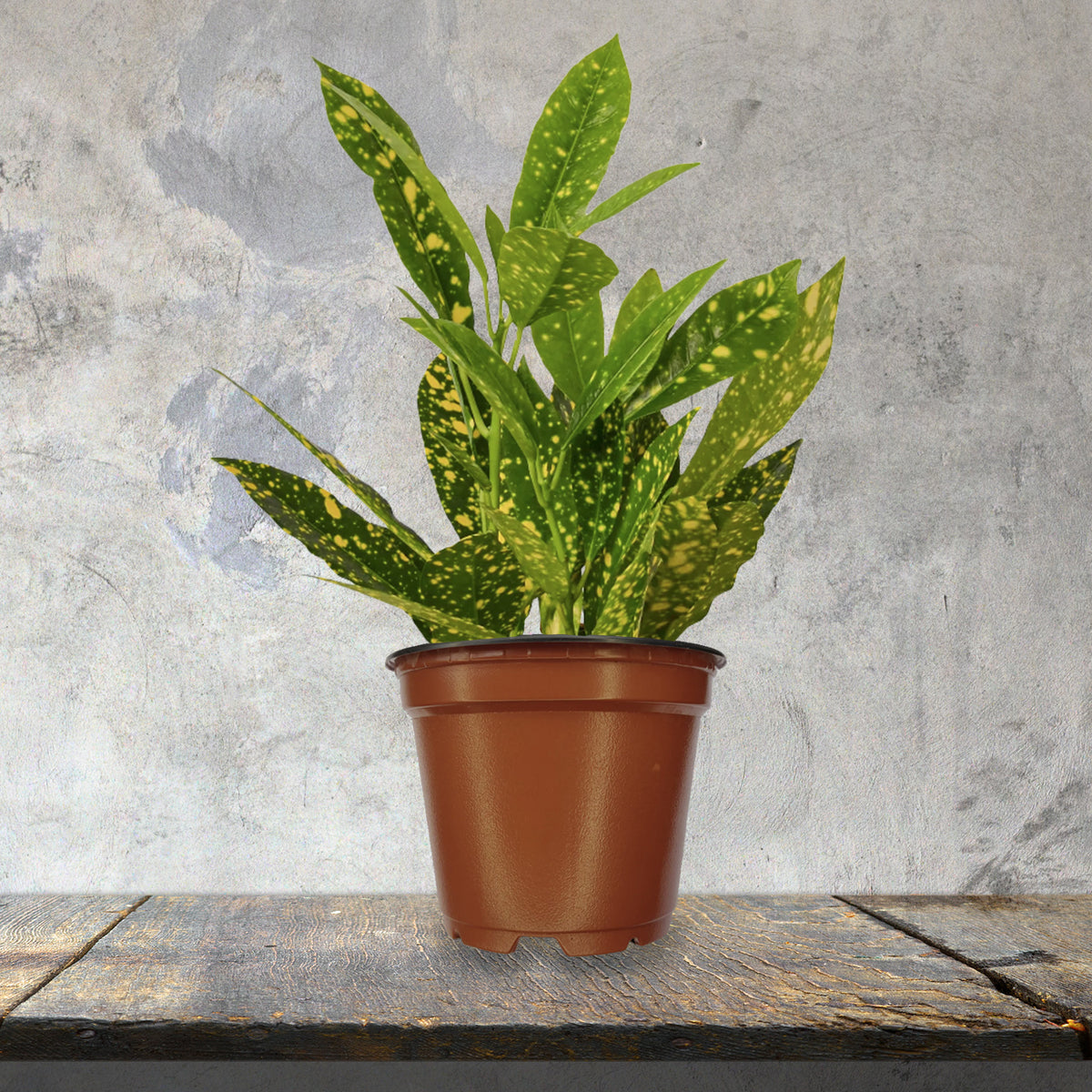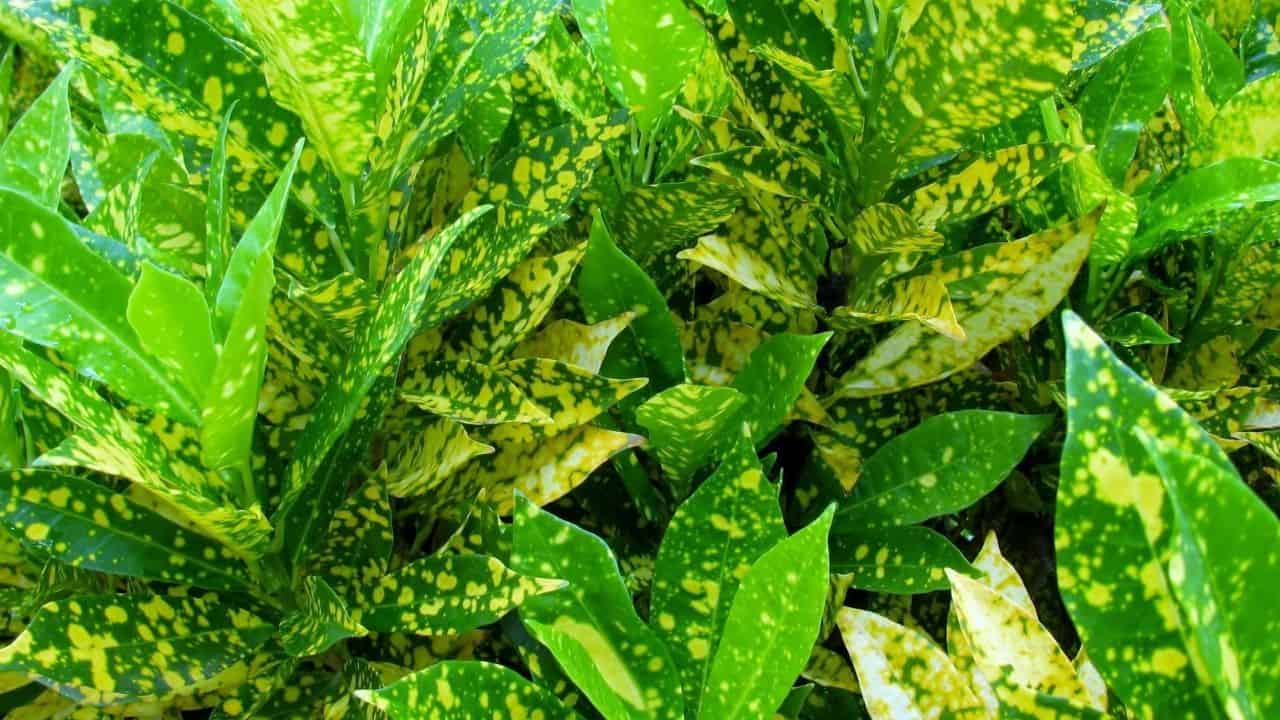Behold the captivating gold dust croton plant, a botanical wonder renowned for its exquisite foliage and therapeutic qualities. Embark on a journey of discovery as we delve into its unique characteristics, cultivation secrets, and diverse applications.
This captivating plant, scientifically known as Codiaeum variegatum, boasts an array of intricate leaf patterns and hues that resemble shimmering gold dust. Its vibrant colors range from emerald green to deep burgundy, creating a kaleidoscope of shades that will enchant any space.
Botanical Characteristics of Gold Dust Croton
Gold Dust Croton, scientifically known as Codiaeum variegatum ‘Gold Dust’, is an ornamental plant prized for its striking and vibrant foliage. Its unique and intricate leaf patterns make it a popular choice for indoor and outdoor gardening enthusiasts alike.
Foliage Characteristics
The Gold Dust Croton boasts elongated and narrow leaves that typically range from 6 to 12 inches in length. The leaves are characterized by their distinct shape, with pointed tips and slightly serrated margins. The most captivating feature of the Gold Dust Croton lies in its foliage’s remarkable color and patterns. The leaves display a kaleidoscope of hues, including shades of green, yellow, orange, and red. These vibrant colors are often adorned with intricate patterns, ranging from simple stripes to complex swirls and blotches.
Growth Habit and Environmental Requirements
The Gold Dust Croton is a relatively slow-growing plant, reaching a mature height of around 3 to 5 feet. It prefers well-drained soil, rich in organic matter, and thrives in bright, indirect light. The plant is tolerant of a wide range of temperatures, but it prefers warm and humid environments, making it an ideal choice for indoor cultivation.
Cultivation and Care of Gold Dust Croton: Gold Dust Croton Plant

Gold dust croton, with its striking foliage and adaptability, makes it a popular choice for gardeners. Cultivating and caring for this plant requires specific techniques to ensure its health and vibrant appearance.
Propagation
Gold dust croton can be propagated through cuttings or seeds. For cuttings, select healthy stems and remove the leaves from the bottom 2-3 inches. Dip the cut end in rooting hormone and plant it in a well-draining potting mix. Keep the cutting moist and in a warm, bright location. For seeds, sow them in a seed starting mix and keep them moist and warm. Once the seedlings emerge, transplant them into individual pots.
Soil Conditions and Lighting
Gold dust croton prefers well-drained, slightly acidic soil with a pH between 6.0 and 6.5. The plant thrives in bright, indirect light. Avoid exposing it to direct sunlight, as this can scorch the leaves.
Watering Schedule
Water the gold dust croton when the top inch of soil is dry to the touch. Avoid overwatering, as this can lead to root rot. During the growing season, fertilize the plant every 2-3 weeks with a balanced fertilizer.
Pests and Diseases, Gold dust croton plant
Gold dust croton is generally resistant to pests and diseases. However, it can be susceptible to mealybugs, spider mites, and scale insects. If pests are present, treat the plant with an appropriate insecticide. The plant can also be affected by fungal diseases such as leaf spot and powdery mildew. If diseases occur, treat the plant with a fungicide.
Uses and Benefits of Gold Dust Croton

Gold Dust Croton, with its vibrant foliage and striking appearance, offers a plethora of benefits beyond its ornamental charm. It has been traditionally employed in various medicinal applications and plays a significant role in modern landscaping and interior design.
Traditional Medicinal Uses
In traditional medicine, Gold Dust Croton has been used for centuries to treat a range of ailments. Its leaves, roots, and bark contain bioactive compounds with potential therapeutic properties.
- Anti-inflammatory: Extracts from Gold Dust Croton have demonstrated anti-inflammatory effects, potentially alleviating pain and swelling in conditions like arthritis and gout.
- Antibacterial: Studies suggest that Gold Dust Croton extracts exhibit antibacterial activity against certain bacteria, including Staphylococcus aureus and Escherichia coli.
- Antimalarial: In some traditional cultures, Gold Dust Croton has been used to combat malaria, although further research is needed to validate its efficacy.
Modern Medicinal Uses
While scientific evidence supporting the traditional medicinal uses of Gold Dust Croton is limited, ongoing research is exploring its potential in modern medicine.
- Cancer research: Extracts from Gold Dust Croton have shown promising anti-cancer properties in laboratory studies, warranting further investigation.
- Antioxidant activity: The plant contains antioxidants that may help protect cells from damage caused by free radicals, potentially reducing the risk of chronic diseases.
Landscaping and Interior Design
Gold Dust Croton’s vibrant foliage makes it a popular choice in landscaping and interior design. Its compact size and tolerance to various conditions allow it to thrive in a wide range of settings.
- Landscaping: Gold Dust Croton is often used as a colorful accent plant in gardens, borders, and containers. Its dense foliage and upright growth habit create a striking visual impact.
- Interior design: The plant’s bright leaves add a touch of color and texture to indoor spaces, making it a popular choice for homes, offices, and public areas.
Toxicity and Safety Considerations
Gold Dust Croton contains a toxic sap that can cause skin irritation and gastrointestinal upset if ingested. It is important to handle the plant with care and avoid contact with the sap.
- Skin irritation: Contact with the sap can cause redness, itching, and blisters on the skin. If contact occurs, wash the affected area with soap and water immediately.
- Ingestion: Ingesting the sap can lead to nausea, vomiting, and abdominal pain. Seek medical attention if ingestion occurs.
